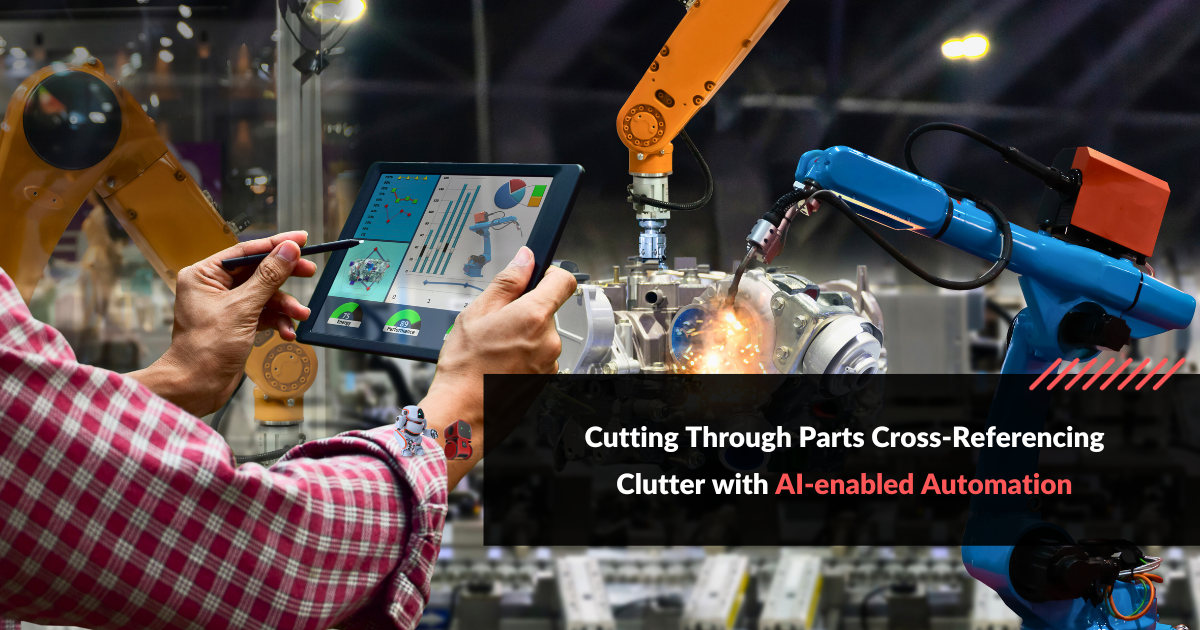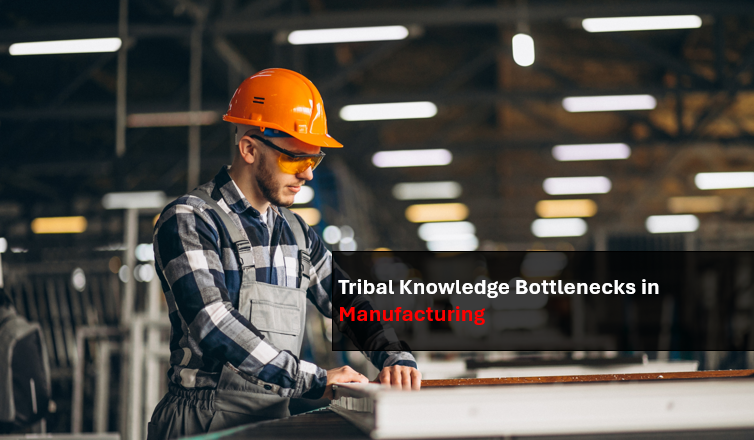Parts cross-referencing is a crucial yet meticulous process in manufacturing, ensuring the right fit and precise functionality across various products. The manual endeavor of matching the correct parts is akin to finding a needle in a haystack, a task both time-consuming and prone to errors.
However, the advent of AI-enabled automation heralds a new era, tirelessly eliminating errors and enhancing efficiency in the manufacturing domain. In this exploration, we delve into the transformative power of AI in parts cross-referencing, unveiling a journey towards heightened accuracy and streamlined operations.
AI-enabled Automation in Parts Cross-Referencing
Manual parts cross-referencing is a time-consuming endeavor. The hours spent sifting through vast catalogs often extend manufacturing timelines significantly. Moreover, the process is prone to human error. A single mistake in identifying the correct part can lead to costly errors, affecting the overall product quality adversely.
The manual method also struggles with handling diverse data formats and massive datasets, creating a bedlam of inconsistencies. Moreover, keeping the information up to date is a constant challenge, raising the risk of utilizing outdated or incorrect parts data. These hurdles not only impede efficiency but also inflate operational costs, making a compelling case for a more streamlined, AI-enabled approach.
Introduction to AI-Enabled Automation
In the manufacturing industry, integrating Artificial Intelligence (AI) into various processes has revolutionized how businesses operate.
AI-enabled automation in manufacturing refers to utilizing advanced AI technologies to streamline and enhance various production processes. When it comes to parts cross-referencing, AI plays a pivotal role in simplifying what was once a time-consuming and error-prone task.
But what does this mean for manufacturing, and why is it so significant?
The valuation of the worldwide manufacturing automation market stood at a remarkable $306.57 billion in 2018, with projections indicating a surge to $514.37 billion by the year 2027. Additionally, forecasts suggest that channeling investments into AI and automation could potentially elevate manufacturing revenue by a notable 10% come 2023.
Key Features and Implementation
Features of AI-enabled Cross-Referencing Systems
AI-enabled cross-referencing systems come packed with a range of features designed to streamline and optimize the parts identification process in manufacturing. These features contribute to making AI a valuable asset in the manufacturing landscape:
- Advanced Data Processing: AI systems excel at processing large volumes of data quickly and accurately. They can handle diverse data formats, including images, specifications, and technical documents, making them versatile in parts identification.
- Pattern Recognition: One of the standout features of AI is its ability to recognize patterns. In cross-referencing parts, this means that AI can identify similarities between different parts, even when presented with minor variations in size, shape, or labeling.
- Machine Learning: AI powered systems can be trained to become progressively better at identifying parts over time. Through machine learning algorithms, these systems become more accurate with each cross-referencing task, continuously improving their performance.
- Real-Time Updates: Manufacturers can access real-time updates and insights into their parts database. This ensures that the cross-referencing process remains up to date with the latest information, reducing the likelihood of using outdated or incorrect parts.
- Integration Capabilities: AI-based cross-referencing systems can seamlessly integrate with existing manufacturing software and databases. This integration simplifies the implementation process and allows for a smoother transition to automated cross-referencing.
Implementation in Manufacturing
Implementing AI-based cross-referencing systems in manufacturing involves a series of strategic steps to ensure seamless integration into existing operations:
- Assessment and Planning: Begin by assessing your current cross-referencing processes and identifying pain points. Determine the specific goals you aim to achieve with AI implementation.
- Data Collection: Gather all relevant data, including part specifications, technical documents, and historical cross-referencing records. High-quality data is essential for training AI systems effectively.
- System Selection: Choose a reputable AI-based cross-referencing system that aligns with your manufacturing needs. Consider factors such as scalability, ease of integration, and the ability to adapt to your data formats.
- Training and Integration: Work closely with the AI provider to train the system using your data. Ensure that the system integrates seamlessly with your existing manufacturing software and databases.
- Testing and Validation: Conduct rigorous testing to validate the accuracy and efficiency of the AI-based cross-referencing system. Compare its results with manual cross-referencing for verification.
- Employee Training: Train your staff in utilizing the AI system effectively. Ensure they understand how to interpret and act upon the system’s recommendations.
- Continuous Monitoring: Implement ongoing monitoring to track the system’s performance and identify areas for improvement. AI systems can adapt to changing data and requirements, so continuous optimization is essential.
- Scalability: As your manufacturing operations grow, ensure that the AI-based cross-referencing system can scale accordingly. This allows you to maintain efficiency as your business expands.
Benefits of AI-enabled automation in Cross-Referencing
- Enhanced Accuracy: AI-enabled automation is incredibly precise when it comes to cross-referencing parts. They can swiftly identify similarities and differences between parts, reducing the chances of human errors that might lead to incorrect identifications. This precision is crucial in manufacturing, where even the smallest mistake can result in costly production issues.
- Improved Efficiency: Gone are the days of manually sifting through vast databases or catalogs to find matching parts. Concepts of AI are used to automate the cross-referencing process, saving a substantial amount of time. What used to take hours or even days can now be accomplished in minutes, allowing manufacturing operations to run smoothly and swiftly.
- Cost Savings: With increased accuracy and efficiency, manufacturers can significantly reduce operational costs. Fewer errors mean less material wastage, decreased production downtime, and minimized labor costs associated with manual cross-referencing.
- Scalability: AI-enabled cross-referencing systems are highly scalable. They can handle a growing volume of parts and data as businesses expand. Scalability ensures that the cross-referencing process remains efficient even as manufacturing operations grow in complexity.
Manufacturers can significantly enhance their parts identification processes by strategically implementing AI-based cross-referencing systems and leveraging their advanced features. The integration of AI not only improves accuracy and efficiency but also positions manufacturing businesses for growth and competitiveness in today’s fast-paced industry. For instance, with Rapid Acceleration Partners’ specialized AI-enabled solutions, you can streamline cross-referencing, enhancing precision, efficiency, and readiness for the challenges of tomorrow’s manufacturing landscape.
Conclusion
The implementation of AI-based cross-referencing systems is not merely a choice; it’s a strategic imperative for manufacturers aiming to stay competitive in today’s fast-paced industry. Manufacturers pave the way for a seamless integration that will pay dividends in precision and efficiency by assessing needs, gathering quality data, and selecting the right AI system.
With AI in their corner, manufacturers can confidently navigate the intricate landscape of parts cross-referencing, knowing they have a powerful tool that enhances productivity and drives success.




